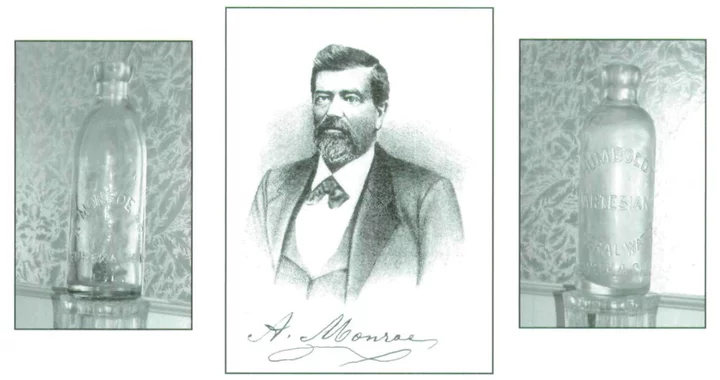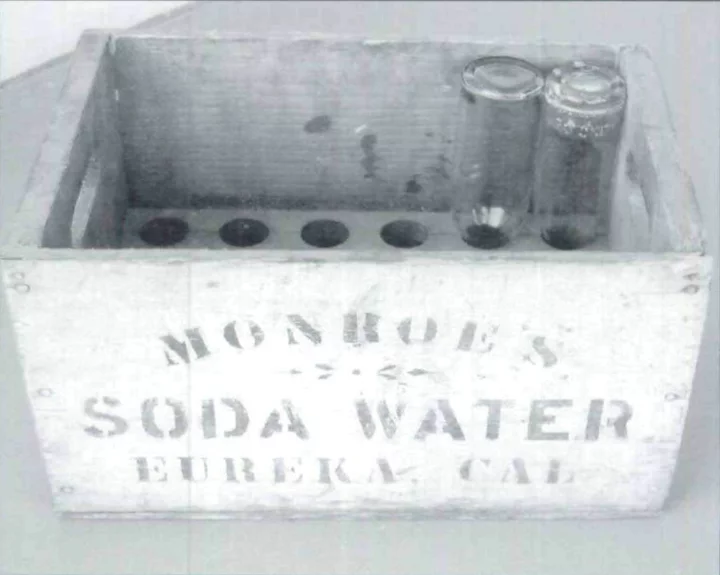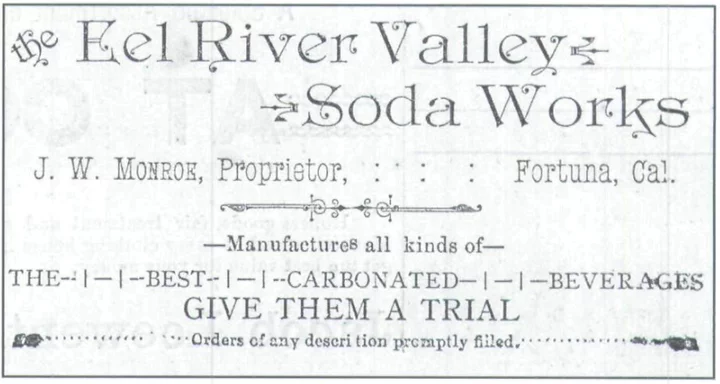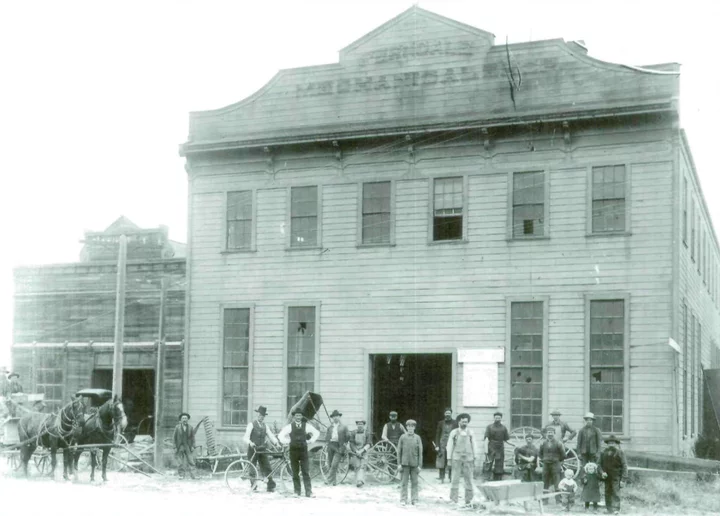Alonzo Monroe with one of his original “A. Monroe” soda bottles, left, and his son Joseph’s bottle for “Humboldt Artesian Mineral Water” right. Photos via the Humboldt Historian.
My grandfather liked to tell stories. As a child, I visited Humboldt County with my parents, and a full litany of family stories would parade through the allotted time. These stories generated an interest in history, genealogy and “old things” that has lasted my whole life.
With mostly the same few stories told, the people in them became both mythically larger than life and insubstantial as ghosts. But an old glass bottle, thick and aqua-colored, with embossed letters spelling “Monroe,” was tangible and real. I became curious about the story behind these bottles.
It begins with my great-great-grandfather, Alonzo W. Monroe, or A. Monroe as he was known in print. An entrepreneur, he made money to make more money. His enterprises were many and varied. And most came to a hard-luck end.
One enterprise that seemed successful was the Monroe House, a three-story building on the southeast corner of 2nd and E streets in Eureka, where Monroe operated a hotel, dining facility, and liquor shop, and also rented out spaces to other shopkeepers. Successful, that is, until January 3, 1876, when it burned to the ground in a spectacular and uninsured manner. His loss was estimated to be $50,000.
Undefeated, Monroe set sail to San Francisco to raise money for a new building. He came back with enough money to begin rebuilding, this time in brick. The conversations he had and the men with whom he talked in San Francisco are not recorded, but one of them must have prompted him to venture into the bottling of soda waters. As a liquor dealer at the beginning of the temperance movement, Monroe may well have considered that a venture which would move him into the temperance market would be a wise investment.
Just seven weeks after the Monroe House fire, the Daily Humboldt Times carried this prominent advertisement:
HUMBOLDT SODA WORKS!
A. Monroe & Co., Proprietors Having secured at a great cost, the necessary machinery, and secured the sole right for this county of the new patent soda bottle, we are now prepared to manufacture first-class
- Soda
- Sarsparilla [sic]
- Champagne Cider
- Bottle Ale & Porter, old stock
- Syrups
- Sarsparilla [sic]
- Lemon and Gum
Which will be sold by the Gallon and warranted to be up to the Standard Weight, All orders for any of the above articles can be left at the wholesale liquor store of A. Monroe.
Patrons in the country supplied immediately on notice.
A. Monroe & Co.
###
The new brick Monroe Building opened in May 1876. During the previous four months, Monroe had been doing business at a temporary location two blocks away. In the new building, Monroe located his liquor store in one of the storefronts opening on E street, between Humboldt County Bank and Opera Alley. Along with the new sodas, he supplied wines, liquors, and whiskies from Kentucky and Virginia, and other beverages from E. Martin & Co. of San Francisco.
Monroe had installed his new soda bottling machinery at the Humboldt Brewery, Messrs. Marhoffer and Wenger, proprietors. In an 1876 article about the Humboldt Brewery, the Daily Humboldt Standard found the process of bottling the soda waters to be worthy of a sideline:
The process of bottling the soda water and sarsparilla [sic] is a very interesting one, it being done with Matthews’ Patent Bottler, and the style of stopper used is a decided improvement on the old system of cork and wire or string. The machine used for washing the bottles is an invention of recent date and is a great saver of labor.
A specialty of the company was the Monroe Champagne Cider. The recipe was secret — obtained like a franchise from someone back East. It was said that the franchise was rare and expensive, and once granted must be kept secret. How Monroe became the only purveyor of Champagne Cider on the West Coast under those requirements remains a mystery. The bubbly cider became the fashionable drink for weddings, christenings and other gala events among those in the emerging temperance movement.
Just two years after launching the bottling works, A. Monroe, age 58, began to have small strokes that progressively robbed him of his mental and physical abilities. Two of his sons were enlisted to help with the business. The oldest son, Joseph Porter Monroe, and the third-born son, young John Welton Monroe, worked in the store as well as in the bottling works. The business became A. Monroe and Son under the management of Joseph P. in June 1878. At about this time, the bottle works were moved from the Humboldt Brewery to Washington and A Streets. The old Sanborn maps show a nice residence at this location, so it may have been Joseph’s home, and the bottling works were added to his property, or vice versa.
A. Monroe died on March 20, 1882 at age 62. At this time, there was a temporary cessation of the soda bottling business.
Alonzo Monroe had not formally filed a will, but a holographic will was discovered and admitted to probate April 22, 1882. The inventory taken included an undivided one-half interest in the Soda Works, value estimated to be $400.00. His widow Anna was named executrix and directed by the deceased to “collect the income of my said property; and to sell such of my property as may be unproductive and place the proceeds at interest or otherwise invest them in productive property; and to invest and reinvest my said property and the proceeds thereof or any portion thereof as circumstances may require.” She was to use the income produced to educate the six remaining minor children, John W., included. Joseph P. was said to have previously received his share of the estate — probably the other one-half interest in the soda works.
This Monroe Soda Water box is typical of early-day soda carriers, in which the bottles were stored upside down.
###
On November 1, 1884, Joseph P. Monroe bought the undivided one-half interest in Eureka Soda Works from the estate for $1,000.00, a nice increase in value. John W., who had been working for his father in the actual manufacturing and bottling part of the business, continued to work for his brother at the bottling plant located at A and Washington Streets in Eureka.
That location, just up the hill from Flannigan and Brossman’s Bayside Lumber Company mill, allowed the addition of another product to the inventory. The steam-powered mill, needing water for its operation, had drilled a well to a depth of 175 feet in order to avoid salt water from the bay. The artesian well they got was more than adequate for their needs, although the mineral content would periodically clog the boilers.
At this time, people ingested mineral water as a cure for whatever ailed them, a practice encouraged by doctors. Joseph P. acquired the franchise to sell water from the mill’s well and sold it under the name Humboldt Artesian Mineral Water. When a the mill was running, its machinery would pump the water uphill to the bottling plant, but when the mill was not running, any Monroe sons or nephews who could be found were conscripted to operate a pump at the bottling plant.
For unknown reasons the brothers went their separate ways. In 1887, at the age of 24, John W. moved to Springville and established a new business, the Eel River Valley Soda Works on 12th Street. When Springville became Fortuna, he took the opportunity to change the name to Monroe Bottling Works, Fortuna, CA. John W. was known to have had a good memory, and must have worked at manufacturing the Champagne Cider for his father, for John W. eventually became the exclusive bottler of the popular Champagne Cider. Neither Joseph nor any of the other Monroes had the secret recipe, leading one to wonder if John chose not to share it, and if this had caused a rift between the brothers.
###
Several things came together for John W. when he moved to Fortuna. In February 1889, he married Augusta Schumacher of Garberville, and with the marriage came a connection to south-of-the-bay Humboldters and access to the thriving apple orchards there. This led his business into more apple-based products such as vinegar, apple butter and jellies along with the Champagne Cider, fruit-flavored sodas, nd sarsaparillas. The business boomed. A plant that had originally cost $3000 to construct and equip had to be enlarged and expanded.
The Eel River Advance of May 30, 1896 reported that Bert Elliott had been hired as a road representative and was increasing sales through Sonoma County and San Francisco. John Butler of San Francisco had made a specialty of advertising the products and was handling about fifty dozen cases a month. The Paciftc Vinegar and Pickle works of San Francisco used the sweet and boiled cider in their products. Ihe sweet cider was shipped in bulk as soon as it was made, so as to be received before fermentation began.
These products proved so popular in Humboldt and elsewhere along the west coast from Southern California up into Oregon that John W. brought his brother Charles Albee Monroe into the business. Charles A. had married Anna Doe of Ferndale in August 1889 and moved there. To keep up with demand, an auxiliary to John’s plant was built in Arlynda, and Charles was put in charge of it. Business continued to boom. The 1897 asked farmers not to sell their apple crop until talking to J.W. Monroe. He wanted one hundred tons of apples for the cider business.
“This success brought in another brother, Horace Perry Monroe, as an assistant to Charles. Horace’s son Perry grew up among the bottling plants. Although he was too young during the time spent there to remember much about the Arlynda plant, he was old enough to remember how his uncle John conducted the Fortuna bottling works.
###
John W. may have inherited his father’s talent for seeing an opportunity, but he also inherited the impatience for the usual business details — like bookkeeping. Perry recalled how John carried the business around in his head, transacting business on the basis of friendships and recording scant details in a little black notebook stuck in his hip pocket, with a stubby pencil from his vest. Mornings he would amble down the street in Fortuna and when he would see one of the storekeepers who carried his products, he would have a conversation, such as:
“Sam, how are you doing? Let’s see now—you must be about out of that batch of soda I brought you last week. I’d say you could use about 14 more.”
Sam would say, “OK.”
And John W. would pull out his notebook and write, “Sam 14.” That would be the extent of his business records. No one else looking over the “records” would know what Sam should get or if he should get 14 bottles or 14 cases.
When collection time came, John W. would see Sam and say, “Sam, you owe me ______.” Sam would take his word for it and pay up.
Perry recalled that the cider had a very smooth taste, but with a kick. The cider vinegar was full of pulp, unlike our grocery store vinegars, and no housewife wanted to cook without it.
John W. kept manufacturing records like he did his orders — the formulas for his sodas and the Champagne Cider were in his head. He died suddenly on November 6, 1902 at the age of forty, leaving a wife and six children to mourn him. Along with loss of a brother, the Monroe boys mourned the loss of the lucrative formula for Champagne Cider.
By May 1903, Peter Delaney, proprietor of City Soda Works in Eureka and a primary competitor to Joseph, bought a part interest in the Fortuna business. Delaney stayed in Eureka to operate City Soda Works, and left the day-to-day workings of the Fortuna plant to Horace P. One has to wonder why Joseph did not buy this share of his brother’s business. The company John built was no longer identified with the Monroe brand. Delaney changed the name to the Eel River Valley Bottling Works. The Arlynda plant was dismantled and moved to add to the Fortuna operation. But by 1907, Horace P. had given up the botthng business in favor of real estate and the law.
The Ferndale Mechanical Shop was purchased in 1904 by Monroe Cider Vinegar Co. It was originally built in 1894 by Oluf Andreasen, pictured above at far right, with his two children.
Charles A. missed the work, or maybe the dependable income of the Arlynda cider works. In 1904, he began again under the name of Monroe Cider and Vinegar Company, Ferndale. He did not have the formula for the Champagne Cider, but he could still supply the sweet and hard ciders, vinegar and apple butter. The company purchased the Mechanical Building on North Main Street and installed bottling equipment.
Another brother, Alonzo Judson Monroe, a lawyer in Eureka, drew up the incorporation papers for the new plant. They needed capital stock of $25,000. This was sold in shares of $10 each. The first offering of stock had raised $8,500 through the sales of fifty shares each to seventeen individuals: James Giacomini, H.C. Blum, G.M. Brice, R.D. Boynton, A.H. Kausen, lames Mullady, loseph Russ, D.A. Francis, Maurice Nielson, CA. Monroe, L.P. Branstetter, lohn Mullady, Henry McDonough, Ira King, Frank Peters, Theodore Rasmussen, and Ben Marolf. The stated purpose of the corporation was written to cover aimost any viable business idea that might occur to the Monroe brothers. Charles A. was both stockholder and manager.
###
All this time, in Eureka, Joseph P. continued his successful run with sodas and mineral water. His plant moved to the 200 block of D Street. With a shrewd bit of marketing, his Humboldt Artesian Mineral Water became famous.
It happened that he sent several cases of said Mineral Water to Chicago, just to “keep the Humboldters healthy” while they promoted their fair county at the Columbian Exposition in 1893. The indefatigable Mrs. R. F. Herrick took as many items as she could to showcase Humboldt County at a booth there. And she probably entered any of the things she could in the competitions at the fair. Humboldt Mineral Water took first prize, causing “an exuberance of joy seldom awakened in the human breast by a beverage of such mild qualities.” Not to be left behind, the California Midwinter International Exposition of 1893-94 awarded the water a gold medal. It, too, acquired a San Francisco distributor, Stephen Jackson, at No. 40 Tliird Street.
An analysis of the water by Prof W. D. Johnston of Cooper Medical College gave these results in grains per imperial gallon:
- Sodium Chloride: 32.01
- Calcium Carbonate: 16.37
- Magnesium: 10.37
- Sodium: 2.45
- Silica: 1.32
- Alumina: .20
- Iron Oxide: .06
and three not always included in the literature—Sulphates, Organic Matter, and Carbonic Acid. The lemon, orange and strawberry sodas, the sarsaparilla, and the lemonade manufactured by Joseph P. all contained the famous water.
By 1914, it seems like the energy of the remaining Monroes had waned. Charles sold his Ferndale building to Central Creamery Company and moved his whole cider and vinegar company to Eureka, to the E Street dock, a short distance from Joseph P’.s bottling works. Now that the two brothers were within blocks of one another, one can’t help wondering why the two brothers didn’t join in a partnership. By 1911, the City Directory no longer had them listed. Joseph P. moved his bottling operation to F Street near Humboldt Street and ran the business out of his home address for the final eleven years.
###
The year 1922 ended the era of the bottling Monroes. Joseph P. Monroe died on February 6, 1922, leaving his son to sell the remaining stock. The lawyer for the family did not even finish the business of the estate for the family. Alonzo J. Monroe died June 14, 1922. Charles A. Monroe died November 5, 1922.
A. Monroe’s final business venture had proved to be something of a success, though he wasn’t there to enjoy it: it lasted for 46 years through his sons.
###
The story above was originally printed in the Fall 2009 issue of the Humboldt Historian, a journal of the Humboldt County Historical Society. It is reprinted here with permission. The Humboldt County Historical Society is a nonprofit organization devoted to archiving, preserving and sharing Humboldt County’s rich history. You can become a member and receive a year’s worth of new issues of The Humboldt Historian at this link.




CLICK TO MANAGE